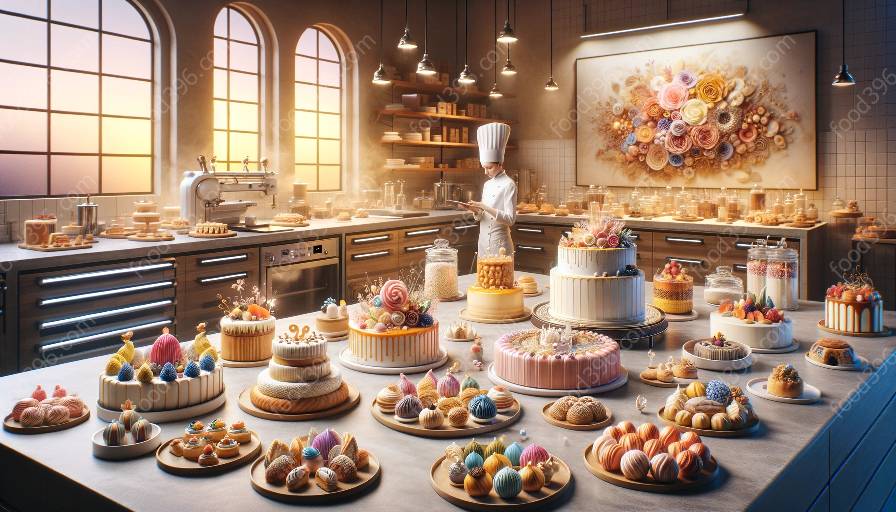Pastry doughs and batters form the foundation of countless sweet and savory delights, playing a crucial role in the world of pastry arts, decorative techniques, and baking science & technology. In this comprehensive guide, we will delve into the diverse world of pastry doughs and batters, exploring their characteristics, uses, and the techniques employed to create an array of delectable treats.
Understanding Pastry Doughs
Pastry doughs are the building blocks of many beloved pastries, pies, tarts, and more. They come in a variety of types, each with its unique characteristics and applications. The most common types of pastry doughs include:
- Pâte Brisée: This classic French pastry dough, also known as shortcrust pastry, is made with a simple mixture of flour, fat (such as butter), salt, and water. It is versatile and can be used for both sweet and savory dishes.
- Pâte Sucrée: A sweet pastry dough that contains sugar, giving it a tender and slightly sweet flavor. It is often used for dessert tarts and tartlets.
- Puff Pastry: Known for its flaky, buttery layers, puff pastry requires meticulous lamination to achieve its signature texture. It is used in both sweet and savory applications, from croissants to vol-au-vents.
- Choux Pastry: This light and airy pastry dough, made with water, butter, flour, and eggs, is used to create iconic pastries such as éclairs, profiteroles, and beignets.
Diving into Pastry Batters
Batters are another essential component of the pastry world, used to create cakes, pancakes, waffles, and a myriad of other baked goods. The distinct types of pastry batters include:
- Cake Batter: Cake batters come in various forms, from butter-based to sponge, and chiffon. Each type produces a different texture and flavor, catering to a wide range of preferences.
- Pancake/Waffle Batter: These batters are lighter in texture, often leavened with baking powder or baking soda to create fluffy, airy pancakes and waffles.
- Tempura Batter: Used in Japanese cuisine, tempura batter is light and crispy, perfect for coating and frying seafood, vegetables, and more.
Artistic Techniques and Pastry Decorations
When it comes to pastry arts and decorative techniques, pastry doughs and batters serve as the canvas upon which stunning creations are brought to life. From intricate lattices on pies to delicate piping on cakes, the artistry and precision involved in pastry decoration require skill and creativity. Common decorative techniques include:
- Piping: Using various tips and techniques to pipe frosting, cream, or other fillings onto pastries, creating intricate designs and decorations.
- Fondant and Gum Paste: These pliable mediums are often used to create elaborate decorations, intricate flowers, and lifelike figurines that adorn cakes and pastries.
- Chocolate Work: From tempering and molding to creating delicate chocolate decorations, the art of working with chocolate adds a touch of elegance to pastries and desserts.
The Science Behind Baking
Understanding the intricacies of baking science and technology is essential for mastering the art of pastry doughs and batters. Factors such as ingredients, temperature, leavening agents, and oven conditions can significantly impact the final outcome of baked goods. Key concepts in baking science include:
- Chemical Leavening: Baking powder, baking soda, and other chemical leaveners play a critical role in achieving the desired texture and rise in baked goods.
- Gluten Formation: The development of gluten in doughs and batters impacts the structure and texture of pastries and baked goods.
- Maillard Reaction: This complex chemical reaction between amino acids and reducing sugars leads to the browning and development of flavor in baked products.
- Oven Technology: Understanding the behavior of different types of ovens, heat distribution, and the impact of steam and convection on baking is crucial for consistent and successful baking.
Conclusion
Pastry doughs and batters are not only the building blocks of delectable treats but also a canvas for artistic expression and a playground for the fascinating science of baking. By mastering the art of working with different doughs and batters, understanding pastry decorations, and appreciating the science behind baking, pastry enthusiasts can unlock endless possibilities for creating extraordinary pastries, desserts, and baked goods.


